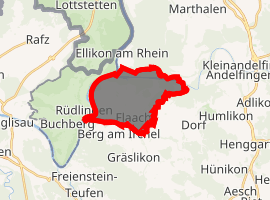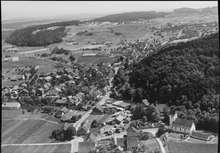Flaach
Flaach is a municipality in the district of Andelfingen in the canton of Zürich in Switzerland.
Flaach | |
|---|---|
 | |
 Coat of arms | |
Location of Flaach 
| |
 Flaach  Flaach | |
| Coordinates: 47°35′N 8°37′E | |
| Country | Switzerland |
| Canton | Zurich |
| District | Andelfingen |
| Area | |
| • Total | 10.16 km2 (3.92 sq mi) |
| Elevation | 360 m (1,180 ft) |
| Population (2018-12-31)[2] | |
| • Total | 1,414 |
| • Density | 140/km2 (360/sq mi) |
| Postal code | 8416 |
| SFOS number | 0028 |
| Surrounded by | Andelfingen, Berg am Irchel, Buchberg (SH), Kleinandelfingen, Marthalen, Rüdlingen (SH), Volken |
| Website | www SFSO statistics |
History

Flaach is first mentioned in 1044 as Flacha, though the only surviving copy of the document dates from 1347.[3]
Geography
Flaach has an area of 10.2 km2 (3.9 sq mi). Of this area, 51.4% is used for agricultural purposes, while 34.2% is forested. Of the rest of the land, 8.2% is settled (buildings or roads) and the remainder (6.2%) is non-productive (rivers, glaciers or mountains).[4]
The municipality is partially agrarian. It is located south of the confluence of the Thur river. The municipality expanded several times at the expense of Berg am Irchel. It expanded in 1619 when Oberdorf joined, in 1775 when Schloss Schollenberg joined and in 1788 when Ziegelhütte joined Flaach.
Schloss Flaach is a Swiss heritage site of national significance.[5]
Demographics
Flaach has a population (as of 31 December 2018) of 1,414.[6] As of 2007, 11.1% of the population was made up of foreign nationals. Over the last 10 years the population has grown at a rate of 10.5%. Most of the population (as of 2000) speaks German (91.6%), with Serbo-Croatian being second most common ( 2.4%) and Albanian being third ( 2.2%).
In the 2007 election the most popular party was the SVP which received 58.3% of the vote. The next three most popular parties were the CSP (12.3%), the SPS (9.2%) and the FDP (6.5%).
The age distribution of the population (as of 2000) is children and teenagers (0–19 years old) make up 29.8% of the population, while adults (20–64 years old) make up 56.3% and seniors (over 64 years old) make up 13.9%. The entire Swiss population is generally well educated. In Flaach about 80.2% of the population (between age 25-64) have completed either non-mandatory upper secondary education or additional higher education (either university or a Fachhochschule).
Flaach has an unemployment rate of 1.56%. As of 2005, there were 123 people employed in the primary economic sector and about 37 businesses involved in this sector. 118 people are employed in the secondary sector and there are 19 businesses in this sector. 426 people are employed in the tertiary sector, with 52 businesses in this sector.[4] The historical population is given in the following table:[3]
| year | population |
|---|---|
| 1467 | 90 Adults |
| 1640 | 577 |
| 1727 | 797 |
| 1836 | 1,002 |
| 1850 | 1,087 |
| 1860 | 1,103 |
| 1900 | 852 |
| 1941 | 716 |
| 1950 | 758 |
| 1980 | 871 |
| 2000 | 1,164 |
Notable residents
The seventh Chief Apostle of the New Apostolic Church, Richard Fehr, was born in Flaach on 15 July 1939.
References
- "Arealstatistik Standard - Gemeinden nach 4 Hauptbereichen". Federal Statistical Office. Retrieved 13 January 2019.
- "Ständige Wohnbevölkerung nach Staatsangehörigkeitskategorie Geschlecht und Gemeinde; Provisorische Jahresergebnisse; 2018". Federal Statistical Office. 9 April 2019. Retrieved 11 April 2019.
- Flaach in German, French and Italian in the online Historical Dictionary of Switzerland.
- Swiss Federal Statistical Office Archived January 5, 2016, at the Wayback Machine accessed 27-Jul-2009
- "Kantonsliste A-Objekte". KGS Inventar (in German). Federal Office of Civil Protection. 2009. Archived from the original on 28 June 2010. Retrieved 25 April 2011.
- Swiss Federal Statistical Office - STAT-TAB, online database – Ständige und nichtständige Wohnbevölkerung nach institutionellen Gliederungen, Geburtsort und Staatsangehörigkeit (in German) accessed 23 September 2019
External links
| Wikimedia Commons has media related to Flaach. |
- Official website (in German)
- Männerchor Flaach
- Flaach in German, French and Italian in the online Historical Dictionary of Switzerland.